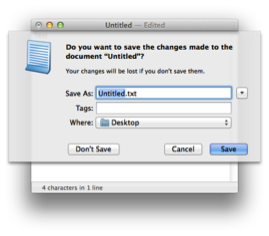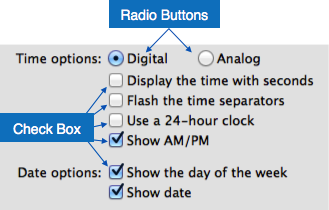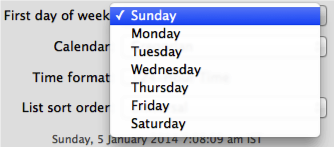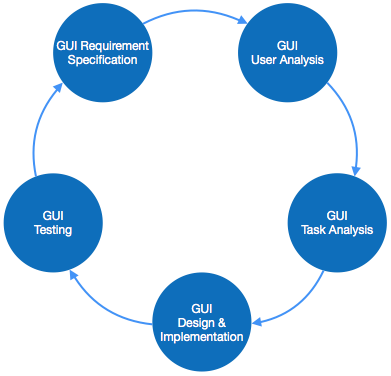Software User Interface Design
User interface is the front-end application view to which user interacts in
order to use the software. User can manipulate and control the software as well
as hardware by means of user interface. Today, user interface is found at almost
every place where digital technology exists, right from computers, mobile
phones, cars, music players, airplanes, ships etc.
User interface is part of software and is designed such a way that it is
expected to provide the user insight of the software. UI provides fundamental
platform for human-computer interaction.
UI can be graphical, text-based, audio-video based, depending upon the
underlying hardware and software combination. UI can be hardware or software or
a combination of both.
The software becomes more popular if its user interface is:
- Attractive
- Simple to use
- Responsive in short time
- Clear to understand
- Consistent on all interfacing screens
UI is broadly divided into two categories:
- Command Line Interface
- Graphical User Interface
Command Line Interface (CLI)
CLI has been a great tool of interaction with computers until the video
display monitors came into existence. CLI is first choice of many technical
users and programmers. CLI is minimum interface a software can provide to its
users.
CLI provides a command prompt, the place where the user types the command and
feeds to the system. The user needs to remember the syntax of command and its
use. Earlier CLI were not programmed to handle the user errors effectively.
A command is a text-based reference to set of instructions, which are
expected to be executed by the system. There are methods like macros, scripts
that make it easy for the user to operate.
CLI uses less amount of computer resource as compared to GUI.
CLI Elements

A text-based command
line interface can have the following elements:
-
Command Prompt - It is text-based notifier that is mostly shows
the context in which the user is working. It is generated by the software
system.
-
Cursor - It is a small horizontal line or a vertical bar of the
height of line, to represent position of character while typing. Cursor is
mostly found in blinking state. It moves as the user writes or deletes
something.
-
Command - A command is an executable instruction. It may have one
or more parameters. Output on command execution is shown inline on the
screen. When output is produced, command prompt is displayed on the next
line.
Graphical User Interface
Graphical User Interface provides the user graphical means to interact with
the system. GUI can be combination of both hardware and software. Using GUI,
user interprets the software.
Typically, GUI is more resource consuming than that of CLI. With advancing
technology, the programmers and designers create complex GUI designs that work
with more efficiency, accuracy and speed.
GUI Elements
GUI provides a set of components to interact with software or hardware.
Every graphical component provides a way to work with the system. A GUI
system has following elements such as:

-
Window - An area where contents of application are displayed.
Contents in a window can be displayed in the form of icons or lists, if the
window represents file structure. It is easier for a user to navigate in the
file system in an exploring window. Windows can be minimized, resized or
maximized to the size of screen. They can be moved anywhere on the screen. A
window may contain another window of the same application, called child
window.
-
Tabs - If an application allows executing multiple instances of
itself, they appear on the screen as separate windows. Tabbed Document
Interface has come up to open multiple documents in the same window.
This interface also helps in viewing preference panel in application. All
modern web-browsers use this feature.
-
Menu - Menu is an array of standard commands, grouped together and
placed at a visible place (usually top) inside the application window. The
menu can be programmed to appear or hide on mouse clicks.
-
Icon - An icon is small picture representing an associated
application. When these icons are clicked or double clicked, the application
window is opened. Icon displays application and programs installed on a
system in the form of small pictures.
-
Cursor - Interacting devices such as mouse, touch pad, digital pen
are represented in GUI as cursors. On screen cursor follows the instructions
from hardware in almost real-time. Cursors are also named pointers in GUI
systems. They are used to select menus, windows and other application
features.
Application specific GUI components
A GUI of an application contains one or more of the listed GUI elements:
-
Application Window - Most application windows uses the constructs
supplied by operating systems but many use their own customer created
windows to contain the contents of application.
-
Dialogue Box - It is a child window that contains message for the
user and request for some action to be taken. For Example: Application
generate a dialogue to get confirmation from user to delete a file.

-
Text-Box - Provides an area for user to type and enter text-based
data.
-
Buttons - They imitate real life buttons and are used to submit
inputs to the software.

-
Radio-button - Displays available options for selection. Only one
can be selected among all offered.
-
Check-box - Functions similar to list-box. When an option is
selected, the box is marked as checked. Multiple options represented by
check boxes can be selected.
-
List-box - Provides list of available items for selection. More
than one item can be selected.

Other impressive GUI components are:
- Sliders
- Combo-box
- Data-grid
- Drop-down list
User Interface Design Activities
There are a number of activities performed for designing user interface. The
process of GUI design and implementation is alike SDLC. Any model can be used
for GUI implementation among Waterfall, Iterative or Spiral Model.
A model used for GUI design and development should fulfill these GUI specific
steps.

-
GUI Requirement Gathering - The designers may like to have list of
all functional and non-functional requirements of GUI. This can be taken
from user and their existing software solution.
-
User Analysis - The designer studies who is going to use the
software GUI. The target audience matters as the design details change
according to the knowledge and competency level of the user. If user is
technical savvy, advanced and complex GUI can be incorporated. For a novice
user, more information is included on how-to of software.
-
Task Analysis - Designers have to analyze what task is to be done
by the software solution. Here in GUI, it does not matter how it will be
done. Tasks can be represented in hierarchical manner taking one major task
and dividing it further into smaller sub-tasks. Tasks provide goals for GUI
presentation. Flow of information among sub-tasks determines the flow of GUI
contents in the software.
-
GUI Design & implementation - Designers after having information
about requirements, tasks and user environment, design the GUI and
implements into code and embed the GUI with working or dummy software in the
background. It is then self-tested by the developers.
-
Testing - GUI testing can be done in various ways. Organization
can have in-house inspection, direct involvement of users and release of
beta version are few of them. Testing may include usability, compatibility,
user acceptance etc.
GUI Implementation Tools
There are several tools available using which the designers can create entire
GUI on a mouse click. Some tools can be embedded into the software environment
(IDE).
GUI implementation tools provide powerful array of GUI controls. For software
customization, designers can change the code accordingly.
There are different segments of GUI tools according to their different use
and platform.
Example
Mobile GUI, Computer GUI, Touch-Screen GUI etc. Here is a list of few tools
which come handy to build GUI:
- FLUID
- AppInventor (Android)
- LucidChart
- Wavemaker
- Visual Studio
User Interface Golden rules
The following rules are mentioned to be the golden rules for GUI design,
described by Shneiderman and Plaisant in their book (Designing the User
Interface).
-
Strive for consistency - Consistent sequences of actions should be
required in similar situations. Identical terminology should be used in
prompts, menus, and help screens. Consistent commands should be employed
throughout.
-
Enable frequent users to use short-cuts - The user’s desire to
reduce the number of interactions increases with the frequency of use.
Abbreviations, function keys, hidden commands, and macro facilities are very
helpful to an expert user.
-
Offer informative feedback - For every operator action, there
should be some system feedback. For frequent and minor actions, the response
must be modest, while for infrequent and major actions, the response must be
more substantial.
-
Design dialog to yield closure - Sequences of actions should be
organized into groups with a beginning, middle, and end. The informative
feedback at the completion of a group of actions gives the operators the
satisfaction of accomplishment, a sense of relief, the signal to drop
contingency plans and options from their minds, and this indicates that the
way ahead is clear to prepare for the next group of actions.
-
Offer simple error handling - As much as possible, design the
system so the user will not make a serious error. If an error is made, the
system should be able to detect it and offer simple, comprehensible
mechanisms for handling the error.
-
Permit easy reversal of actions - This feature relieves anxiety,
since the user knows that errors can be undone. Easy reversal of actions
encourages exploration of unfamiliar options. The units of reversibility may
be a single action, a data entry, or a complete group of actions.
-
Support internal locus of control - Experienced operators strongly
desire the sense that they are in charge of the system and that the system
responds to their actions. Design the system to make users the initiators of
actions rather than the responders.
-
Reduce short-term memory load - The limitation of human
information processing in short-term memory requires the displays to be kept
simple, multiple page displays be consolidated, window-motion frequency be
reduced, and sufficient training time be allotted for codes, mnemonics, and
sequences of actions.





